GHG mitigation strategies on China’s diverse dish consumption are key to meet the Paris Agreement targets
Combatting climate change depends on demand-side mitigation strategies related to food, which is in turn contingent on explicit estimation and management of dish-level emissions. Here, on the basis of a bottom-up integrated emissions framework, we first estimate the greenhouse gas emissions of 540 dishes from 36 cuisines using data from over 800,488 restaurants in China’s provincial capital cities. By mining residents’ dietary preferences, we then design various dietary change strategies to explicitly link food emissions to the Paris Agreement pledges. The results show that China’s food system greenhouse gas emissions were approximately 4.64 GtCO2eq in 2020, accounting for 37% of total emissions, with average per-dish emissions of 8.44 kgCO2eq. Current emission patterns of food consumption in China may not be consistent with the attainment of the 1.5 °C and 2 °C climate targets, but transitioning towards low-emission cuisines and dishes could change that by reducing emissions by 38–69%.
This is a preview of subscription content, access via your institution
Access options
Access Nature and 54 other Nature Portfolio journals
Get Nature+, our best-value online-access subscription
cancel any time
Subscribe to this journal
Receive 12 digital issues and online access to articles
133,45 € per year
only 11,12 € per issue
Buy this article
- Purchase on SpringerLink
- Instant access to full article PDF
Prices may be subject to local taxes which are calculated during checkout
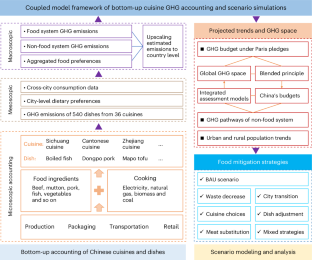
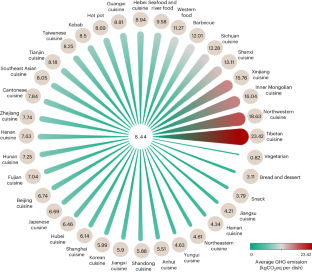
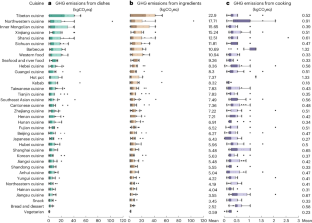
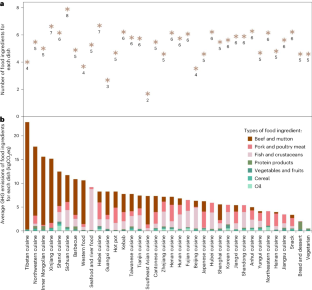
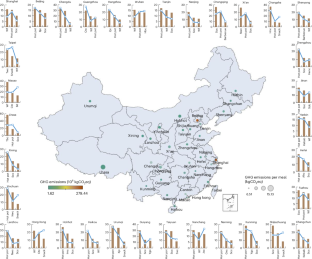
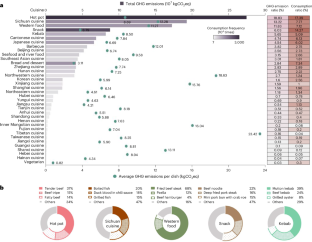
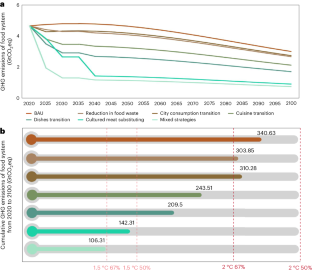
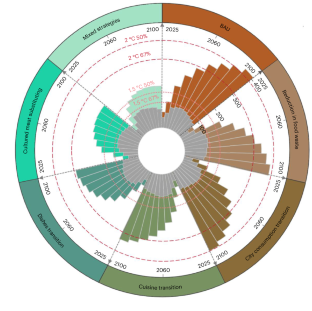
Similar content being viewed by others
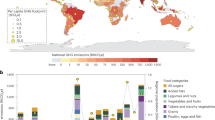
Reducing climate change impacts from the global food system through diet shifts
Article Open access 13 August 2024

Simple dietary substitutions can reduce carbon footprints and improve dietary quality across diverse segments of the US population
Article 26 October 2023
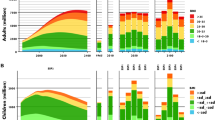
The ongoing nutrition transition thwarts long-term targets for food security, public health and environmental protection
Article Open access 18 November 2020
Data availability
The data supporting the findings of this study are available within the paper and Supplementary Information. The observed dish consumption data of restaurants in the representative cities are derived from https://www.dianping.com/. The data of food ingredient type, weight and cooking time for dishes from the recipes ‘The Cookbook China’ 27 , ‘A Bite of China’ 28 and https://www.meishij.net/. China’s population projections are taken from https://databank.worldbank.org/source/population-estimates-and-projections. The emission factors of food ingredients are provided by Poore and Nemecek (2018) entitled ‘Reducing foods environmental impacts through producers and consumers’ (https://doi.org/10.1126/science.aaq0216). Residents’ per capita consumption of food ingredients data are from the National Bureau of Statistics of China, available at https://www.stats.gov.cn/. All necessary data in this study could be accessed via GitHub at https://github.com/naturefood/NF_Dish-consumption-data. Source data are provided with this paper.
Code availability
The data collecting and processing are conducted in Microsoft Excel 2020, Python (v.3.9) and Eureqa (v.1.24.0), while Tableau (v.10.5) is used to visualize the results. More details on codes are available from the corresponding authors upon request.
References
- Rosenzweig, C. et al. Climate change responses benefit from a global food system approach. Nat. Food1, 94–97 (2020). ArticlePubMedGoogle Scholar
- Campbell, B. M., Thornton, P. K. & Nelson, G. C. Upping our ambition for food system adaptation. Nat. Food3, 970–971 (2022). ArticlePubMedGoogle Scholar
- Crippa, M. et al. Food systems are responsible for a third of global anthropogenic GHG emissions. Nat. Food2, 198–209 (2021). ArticleCASPubMedGoogle Scholar
- Soergel, B. et al. A sustainable development pathway for climate action within the UN 2030 Agenda. Nat. Clim. Change11, 656–664 (2021). ArticleADSGoogle Scholar
- Clark, M. A. et al. Global food system emissions could preclude achieving the 1.5 °C and 2 °C climate change targets. Science370, 705–708 (2020). ArticleADSCASPubMedGoogle Scholar
- Springmann, M. et al. Options for keeping the food system within environmental limits. Nature562, 519–525 (2018). ArticleADSCASPubMedGoogle Scholar
- Chinese food culture. China Discoveryhttps://www.chinadiscovery.com/chinese-food/food-culture.html (2020).
- Henry, R. C., Alexander, P., Rabin, S., Anthoni, P. & Arneth, A. The role of global dietary transitions for safeguarding biodiversity. Global Environ. Change58, 101956 (2019). ArticleGoogle Scholar
- Vieux, F., Perignon, M., Gazan, R. & Darmon, N. Dietary changes needed to improve diet sustainability: are they similar across Europe? Eur. J. Clin. Nutr.72, 951–960 (2018). ArticlePubMedPubMed CentralGoogle Scholar
- Poore, J. & Nemecek, T. Reducing food’s environmental impacts through producers and consumers. Science360, 987–992 (2018). ArticleADSCASPubMedGoogle Scholar
- Hoolohan, C., Berners-Lee, M., McKinstry-West, J. & Hewitt, C. Mitigating the greenhouse gas emissions embodied in food through realistic consumer choices. Energy Policy63, 1065–1074 (2013). ArticleGoogle Scholar
- Vermeir, I. et al. Environmentally sustainable food consumption: a review and research agenda from a goal-directed perspective. Front. Psychol.11, 1603 (2020). ArticlePubMedPubMed CentralGoogle Scholar
- Li, Y. et al. Changes in global food consumption increase GHG emissions despite efficiency gains along global supply chains. Nat. Food4, 483–495 (2023). ArticleCASPubMedGoogle Scholar
- Reisch, L. A. Shaping healthy and sustainable food systems with behavioural food policy. Eur. Rev. Agricult. Econ.4, 665–693 (2021). Google Scholar
- Cobiac, L. et al. Accounting for consumers’ preferences in the analysis of dietary recommendations. Eur. J. Clin. Nutr.73, 1033–1039 (2019). ArticleCASPubMedGoogle Scholar
- Asano, Y. M. & Biermann, G. Rising adoption and retention of meat-free diets in online recipe data. Nat. Sustain.2, 621–627 (2019). ArticleGoogle Scholar
- Camilleri, A. R., Larrick, R. P., Hossain, S. & Patino-Echeverri, D. Consumers underestimate the emissions associated with food but are aided by labels. Nat. Clim. Change9, 53–58 (2019). ArticleADSGoogle Scholar
- Lohmann, P. M., Gsottbauer, E., Doherty, A. & Kontoleon, A. Do carbon footprint labels promote climatarian diets? Evidence from a large-scale field experiment. J. Environ. Econ. Manag.114, 102693, (2022).
- Cui, Z. et al. Pursuing sustainable productivity with millions of smallholder farmers. Nature555, 363–366 (2018). ArticleADSCASPubMedGoogle Scholar
- Tubiello, F. N. et al. Pre- and post-production processes increasingly dominate greenhouse gas emissions from agri-food systems. Earth Syst. Sci. Data14, 1795–1809 (2022). ArticleADSGoogle Scholar
- Li, M. et al. Global food-miles account for nearly 20% of total food-systems emissions. Nat. Food3, 445–453 (2022). ArticleCASPubMedGoogle Scholar
- Tilman, D. & Clark, M. Global diets link environmental sustainability and human health. Nature515, 518–522 (2014). ArticleADSCASPubMedGoogle Scholar
- Willett, W. et al. Food in the Anthropocene: the EAT–Lancet Commission on healthy diets from sustainable food systems. Lancet393, 447–492 (2019). ArticlePubMedGoogle Scholar
- Xu, X., Sharma, P., Shu, S., Lin, T. S. & Jain, A. K. Global greenhouse gas emissions from animal-based foods are twice those of plant-based foods. Nat. Food2, 724–732 (2021). ArticleCASPubMedGoogle Scholar
- Frankowska, A. et al. Impacts of home cooking methods and appliances on the GHG emissions of food. Nat. Food1, 787–791 (2020). ArticleCASPubMedGoogle Scholar
- Song, F. & Cho, M. S. Geography of food consumption patterns between south and north China. Foods6, 34 (2017). ArticlePubMedPubMed CentralGoogle Scholar
- Chen, J. & Fang, X. The Cookbook China (Sichuan People’s Publishing House, 2021).
- Chen, T. A Bite of China (The Chinese Overseas Publishing House, 2018).
- Mazac, R. et al. Incorporation of novel foods in European diets can reduce global warming potential, water use and land use by over 80%. Nat. Food3, 286–293 (2022). ArticlePubMedGoogle Scholar
- Tuomisto, H. L., Allan, S. J. & Ellis, M. J. Prospective life cycle assessment of a complete bioprocess design for cultured meat production in hollow fiber bioreactors. Sci. Total Environ.851, 158051 (2022). ArticleADSCASPubMedGoogle Scholar
- Luderer, G. et al. Residual fossil CO2 emissions in 1.5–2 °C pathways. Nat. Clim. Change8, 626–663 (2018). ArticleADSCASGoogle Scholar
- Duan, H. et al. Assessing China’s efforts to pursue the 1.5 °C warming limit. Science372, 378–385 (2021). ArticleADSCASPubMedGoogle Scholar
- World trade statistical review. World Trade Organizationhttps://www.wto.org/english/res_e/booksp_e/wtsr_2022_e.pdf (2022).
- Scarborough, P. et al. Vegans, vegetarians, fish-eaters and meat-eaters in the UK show discrepant environmental impacts. Nat. Food4, 565–574 (2023). ArticlePubMedPubMed CentralGoogle Scholar
- Garnett, E. E., Balmford, A., Sandbrook, C., Pilling, M. A. & Marteau, T. M. Impact of increasing vegetarian availability on meal selection and sales in cafeterias. Proc. Natl Acad. Sci. USA116, 20923–20929 (2019). ArticleADSCASPubMedPubMed CentralGoogle Scholar
- Biesbroek, S. et al. Toward healthy and sustainable diets for the 21st century: importance of sociocultural and economic considerations. Proc. Natl Acad. Sci. USA120, e2219272120 (2023). ArticleCASPubMedPubMed CentralGoogle Scholar
- Guidelines for the Preparation of Provincial Greenhouse Gas Inventories (National Development and Reform Commission Office, 2011).
- China Population Census Yearbook (Office of the Leading Group of the State Council, 2020).
- Wu, C., Che, H., Chan, T. & Lu, X. The economic value of online reviews. Market. Sci.34, 739–754 (2015). ArticleGoogle Scholar
- Webb, D. & Byrd-Bredbenner, C. Overcoming consumer inertia to dietary guidance. Adv. Nutr.6, 391–396 (2015). ArticlePubMedPubMed CentralGoogle Scholar
- Annual Observation and Big Data of Chinese Catering (Meituan Research Institute, 2022).
- E-commerce in China. People’s Republic of China Ministry of Commercehttp://images.mofcom.gov.cn/dzsws/202211/20221118180137127.pdf (2021).
- China statistical yearbook. National Bureau of Statistics of Chinahttp://www.stats.gov.cn/sj/ndsj/2021/indexch.htm (2021).
- Historical GHG emissions. World Resources Institutehttps://www.climatewatchdata.org/ghg-emissions (2022).
- Raupach, M. R. et al. Sharing a quota on cumulative carbon emissions. Nat. Clim. Change4, 873–879 (2014). ArticleADSCASGoogle Scholar
- Population estimates and projections. The World Bankhttps://databank.worldbank.org/source/population-estimates-and-projections (2022).
- Schmidt, M. & Lipson, H. Distilling free-form natural laws from experimental data. Science324, 81–85 (2009). ArticleADSCASPubMedGoogle Scholar
- Bajželj, B. et al. Importance of food-demand management for climate mitigation. Nat. Clim. Change4, 924–929 (2014). ArticleADSGoogle Scholar
- Gustavsson, J., Cederberg, C., Sonesson, U., van Otterdijk, R. & Meybeck, A. Global Food Losses and Food Waste: Extent, Causes and Prevention (Food and Agricultural Organization, 2011).
- Stephens, D. N. et al. Bringing cultured meat to market: technical, socio-political, and regulatory challenges in cellular agriculture. Trends Food Sci. Technol.78, 155–166 (2018). ArticleCASPubMedPubMed CentralGoogle Scholar
- Parodi, A. et al. The potential of future foods for sustainable and healthy diets. Nat. Sustain.1, 782–789 (2018). ArticleGoogle Scholar
- Tuomisto, H. L. & Teixeira de Mattos, M. J. Environmental impacts of cultured meat production. Environ. Sci. Technol.45, 6117–6123 (2011). ArticleADSCASPubMedGoogle Scholar
Acknowledgements
We acknowledge funding from the National Natural Science Foundation of China (72325008, 72101051, 71988101 and 72293565), the National Key Research and Development Program of China (2020YFA0608603) and the Fundamental Research Funds for the Central Universities in China.
Author information
Authors and Affiliations
- School of Management Science and Engineering, Dongbei University of Finance and Economics, Dalian, China Xian Yang & Qian Gao
- School of Economics and Management, University of Chinese Academy of Sciences, Beijing, China Hongbo Duan & Shouyang Wang
- PanshiData Technology, Shenyang, China Muhua Zhu
- Academy of Mathematics and Systems Science, Chinese Academy of Sciences, Beijing, China Shouyang Wang
- Xian Yang












